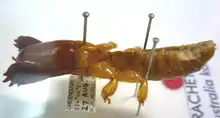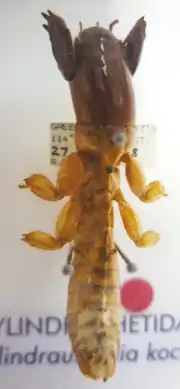Sandgroper (insect)
Sandgropers are wholly subterranean larviform insects of the family Cylindrachetidae that may grow up to 7 cm (3 in) long. Three genera are currently recognised: Cylindracheta, Cylindraustralia and Cylindroryctes. Like many subterranean animals, little is known about their habits and diet, but Western Australian farmers have blamed them for substantial crop losses.

| Cylindrachetidae | |
|---|---|
 | |
| Cylindraustralia kochii | |
| Scientific classification | |
| Kingdom: | |
| Phylum: | |
| Class: | |
| Order: | |
| Suborder: | |
| Superfamily: | |
| Family: | Cylindrachetidae (Giglio-Tos, 1914) |
| Genera | |
|
Cylindracheta | |
Sandgropers were once thought to be degenerate mole crickets, but they are now known to be more closely related to pygmy mole crickets, in the Caelifera: which includes grasshoppers.
Although widely believed to be herbivorous, some have been found with animal remains in their gut.
Range
- Australia:
- Cylindracheta is found only in the Northern Territory
- Cylindraustralia widely except in the south-east and Tasmania
- six species have been recorded in Western Australia of which five are believed to be endemic to that state. C. kochii and C. tindalei are found in the Perth region.
- New Guinea:
- Cylindraustralia
- Argentina:
- Cylindroryctes
Popular culture
In the 1970s, television station TVW Channel 7 in Perth, Western Australia released a stuffed toy sandgroper for sale named "Sunny The Sandgroper", with proceeds going towards Telethon. "Sunny Sandgroper" was then used as a regular character, along with Fat Cat and Percy P Penguin, in TVW-7's 'Earlybirds' morning children's show. West Australians have been known colloquially as sandgropers, with references to the name being found as early as the 1890s.[1]
References
| Wikispecies has information related to Cylindrachetidae. |
- "Sandgropers". Western Australian Museum. Retrieved September 30, 2006.
- Marshall Martin (2005-05-21). "Real Sandgroper revealed". ABC.
- "Fitzroy City Press". Fitzroy City Press (Vic. : 1881 - 1920). Vic.: National Library of Australia. 31 January 1896. p. 2. Retrieved 23 October 2011.